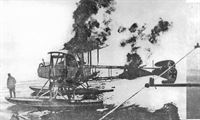
Описание
Страна: Германия
Год: 1916
Twin-engined torpedo aircraft
Варианты
- Gotha - WD.7 - 1916 - Германия
- Gotha - WD.11 - 1917 - Германия
- Gotha - WD.14/WD.20 - 1917 - Германия
- Gotha - WD.22 - 1918 - Германия
- Gotha - WD.27 - 1918 - Германия
- В.Обухович, А.Никифоров Самолеты Первой Мировой войны
- O.Thetford, P.Gray German Aircraft of the First World War (Putnam)
- J.Herris Gotha Aircraft of WWI (A Centennial Perspective on Great War Airplanes 6)
- M.Schmeelke "Torpedo Los!" (Aeronaut)
- M.Dusing German Aviation Industry in WWI. Volume 1 (A Centennial Perspective on Great War Airplanes 84)
-
M.Schmeelke - "Torpedo Los!" /Aeronaut/
Gotha WD7 #119, Flgmstr. Kaspar & Flgmstr. Rund, April 1916
-
J.Herris - Gotha Aircraft of WWI /Centennial Perspective/ (6)
The prototype Gotha WD7, Marine #119, in the Gotha factory pond. The WD7 had distinctive tail surfaces with three fins and two rudders with aerodynamic balances at the bottom. The WD7 was designed as a 3-seat Kampfflugzeug meant to destroy enemy aircraft, but by the time the production batch was available that concept was out-moded.
-
J.Herris - Gotha Aircraft of WWI /Centennial Perspective/ (6)
The Gotha WD7 prototype was MN 119; it was powered by 120 hp Mercedes D.II engines.
-
J.Herris - Gotha Aircraft of WWI /Centennial Perspective/ (6)
On its first combat mission on 5 April 1916, WD7 Marine Number 119 caught fire in flight and was forced to make an emergency landing. Here it is photographed from a French vessel that captured the crew and partly-burnt airframe.
-
J.Herris - Gotha Aircraft of WWI /Centennial Perspective/ (6)
Gotha WD7 #119 after capture. The WD7 was indeed "brought down in flames off the coast of Dunkirk" as written on the photograph but that was due to mechanical failure, not Allied action. WD7 #119 was the subject of a French report in L'Aerophile from where we learn it was doped a very light blue.
-
H.Cowin - Aviation Pioneers /Osprey/
Seven of these three seat Gotha WD-7s, 670 to 676, were built as torpedo-dropping trainers during 1916. Powered by two 120hp Mercedes DIIs, the machines had a top level speed of 85mph, while their normal operating range was 295 miles. The aircraft seen here was operated from the Norderney naval seaplane base.
-
M.Schmeelke - "Torpedo Los!" /Aeronaut/
Gotha WD7 (670) was transported to Kiel as a training aircraft on July 1, 1916.
-
J.Herris - Gotha Aircraft of WWI /Centennial Perspective/ (6)
Gotha WD7 Marine Number 671 afloat in the Gotha factory pond.
-
M.Schmeelke - "Torpedo Los!" /Aeronaut/
Gotha WD7 672 souvenir picture.
-
M.Schmeelke - "Torpedo Los!" /Aeronaut/
Gotha WD7 672 on the slipway in Flensburg.
-
M.Dusing - German Aviation Industry in WWI. Volume 2 /Centennial Perspective/ (85)
The Gotha WD 7 had two Daimler D.II engines and two integral propellers (1915/16).
-
J.Herris - Gotha Aircraft of WWI /Centennial Perspective/ (6)
Side view of Gotha WD7 Marine Number 674 on a dolley. Power for MN 670-675 was two 100 hp Mercedes D.I engines; MN 676 was powered by 120 Argus As.II engines.
-
C.Owers - Hansa-Brandenburg Aircraft of WWI. Volume 1 - Landplanes /Centennial Perspective/ (17)
A typical Norderney winter scene with a Brandenburg FB hiding at the waterline with Gotha WD7 MN 674 at left and Brandenburg NW (Gotha WD12 ???) floatplanes
Другие самолёты на фотографии: Gotha WD.12/WD.13/WD.15 - Германия - 1917Hansa-Brandenburg FB - Германия - 1915
-
M.Schmeelke - "Torpedo Los!" /Aeronaut/
Gotha WD7 (675) in Flensburg, December 1916. (KMF)
-
M.Schmeelke - "Torpedo Los!" /Aeronaut/
III.T-Flugzeuggruppe drops practice torpedoes in the Bay of Kiel, from their Gotha WD7 trainers. (KMF)
-
M.Schmeelke - "Torpedo Los!" /Aeronaut/
Above: Broken float on Gotha 672 in Flensburg. (KMF)
Below: Gotha WD7 672 accident in Apenrade. The aircraft was recovered by SMS Nautilus and transported to Fahrensodde. (KMF)
В.Обухович, А.Никифоров Самолеты Первой Мировой войны
Компания "Готаэр" по заданию флота сконструировала ряд двухмоторных гидросамолетов. При этом был использован опыт создания бомбардировщиков класса "G", хотя внешне гидросамолеты и значительно отличались от сухопутных машин. Двухмоторный поплавковый биплан W.D. 7 разрабатывался как разведчик и патрульный самолет. Оснащался двигателями Мерседес D.II с тянущими винтами. Отличительной чертой машины было довольно редкое, на то время, разнесенное по концам стабилизатора вертикальное оперение. Стрелок размещался в передней кабине, оснащенной подвижным пулеметом. Всего было произведено 8 самолетов W.D. 7.
Из-за низких летных характеристик они в основном применялись в учебных отрядах. Известен случай, когда один из гидросамолетов, выполняя патрульный полет, совершил вынужденную посадку на воду вблизи французских кораблей. Экипаж попытался сжечь машину, но не успел.
Технические данные Гота W.D. 7
Двигатель 2 х Мерседес D.II (120 л. С.)
Размеры:
размах х длина 16,8 х 11,3 м
Площадь крыльев 55,5 м2
Вес:
пустого 1275 кг
взлетный 1785 кг
Максимальная скорость 128 км/ч
Потолок 3500 м
Дальность полета 475 км
Вооружение:
стрелковое 1 подвижный пулемет
Экипаж 2 чел.
Описание:




















